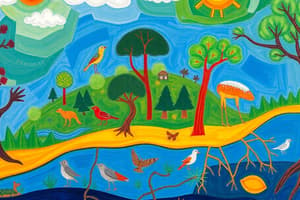Podcast
Questions and Answers
What constitutes an ecosystem?
What constitutes an ecosystem?
- Only living organisms in a specific area
- Only the non-living surroundings in an area
- Only plants and animals in their natural habitat
- The interaction of biotic and abiotic components (correct)
Which of the following is an example of a human-made ecosystem?
Which of the following is an example of a human-made ecosystem?
- A mountain ecosystem
- A garden (correct)
- A rainforest
- A pond in nature
Which abiotic component is NOT mentioned as a part of the ecosystem?
Which abiotic component is NOT mentioned as a part of the ecosystem?
- Rainfall
- Soil
- Fungi (correct)
- Temperature
How do biotic components in an ecosystem generally interact with abiotic components?
How do biotic components in an ecosystem generally interact with abiotic components?
What role do plants play in an aquarium ecosystem?
What role do plants play in an aquarium ecosystem?
Which of the following is considered an abiotic component?
Which of the following is considered an abiotic component?
What is one key feature of an aquarium as a human-made ecosystem?
What is one key feature of an aquarium as a human-made ecosystem?
What is the effect of environmental changes as suggested by elders?
What is the effect of environmental changes as suggested by elders?
What is the correct order of trophic levels in a food chain starting from the producers?
What is the correct order of trophic levels in a food chain starting from the producers?
What is the role of autotrophs in a food chain?
What is the role of autotrophs in a food chain?
What happens to energy as it flows through a food chain?
What happens to energy as it flows through a food chain?
Which of the following is true regarding primary consumers?
Which of the following is true regarding primary consumers?
What is the primary source of energy for living organisms in an ecosystem?
What is the primary source of energy for living organisms in an ecosystem?
Which organisms are considered tertiary consumers?
Which organisms are considered tertiary consumers?
What is true about decomposers in the food chain?
What is true about decomposers in the food chain?
At which trophic level do the autotrophs operate?
At which trophic level do the autotrophs operate?
What percentage of the sunlight energy captured by green plants is converted into food energy?
What percentage of the sunlight energy captured by green plants is converted into food energy?
How much energy is typically converted into the biomass of primary consumers from the food they consume?
How much energy is typically converted into the biomass of primary consumers from the food they consume?
What factor limits the number of trophic levels in a food chain?
What factor limits the number of trophic levels in a food chain?
Which trophic level typically has the greatest number of individuals in an ecosystem?
Which trophic level typically has the greatest number of individuals in an ecosystem?
What is the term used to describe a more complex representation of feeding relationships in an ecosystem?
What is the term used to describe a more complex representation of feeding relationships in an ecosystem?
What happens to the energy lost when green plants are consumed by primary consumers?
What happens to the energy lost when green plants are consumed by primary consumers?
How is the flow of energy characterized in an ecosystem?
How is the flow of energy characterized in an ecosystem?
Which of the following best describes the energy transfer efficiency in ecosystems?
Which of the following best describes the energy transfer efficiency in ecosystems?
What characteristic defines biodegradable substances?
What characteristic defines biodegradable substances?
Which of the following statements about non-biodegradable substances is NOT true?
Which of the following statements about non-biodegradable substances is NOT true?
How do biodegradable substances predominantly affect the environment?
How do biodegradable substances predominantly affect the environment?
What happens to non-biodegradable substances over time?
What happens to non-biodegradable substances over time?
Which type of materials tend to be broken down by heat and pressure?
Which type of materials tend to be broken down by heat and pressure?
Which property differentiates biodegradable and non-biodegradable substances?
Which property differentiates biodegradable and non-biodegradable substances?
What is an example of a challenge associated with non-biodegradable substances?
What is an example of a challenge associated with non-biodegradable substances?
Which of the following actions represents a way to manage biodegradable waste effectively?
Which of the following actions represents a way to manage biodegradable waste effectively?
What role do producers play in an ecosystem?
What role do producers play in an ecosystem?
What impact do chemicals like CFCs have on the environment?
What impact do chemicals like CFCs have on the environment?
Which of these groups contain only biodegradable items?
Which of these groups contain only biodegradable items?
What consequence might occur if all organisms in one trophic level are removed?
What consequence might occur if all organisms in one trophic level are removed?
Which of the following describes a food chain?
Which of the following describes a food chain?
Which practice would be considered environment-friendly?
Which practice would be considered environment-friendly?
What limits the number of trophic levels in a food chain?
What limits the number of trophic levels in a food chain?
What kind of waste contributes to serious environmental problems?
What kind of waste contributes to serious environmental problems?
Flashcards are hidden until you start studying
Study Notes
Ecosystem
-
An ecosystem is a complex system where living organisms (biotic components) interact with their non-living environment (abiotic components) to maintain a balance.
-
Biotic components: include plants, animals, microorganisms, and humans.
-
Abiotic components: include physical factors like temperature, rainfall, wind, soil, and minerals.
-
Examples of ecosystems: gardens, forests, ponds, lakes.
-
Natural ecosystems: forests, ponds, lakes.
-
Artificial ecosystems: gardens, crop-fields.
Food Chains and Webs
-
A food chain is a series of organisms in an ecosystem where each organism eats the one below it and is eaten by the one above it.
-
Trophic levels: Each step or level in a food chain represents a trophic level.
-
Producers (autotrophs): Plants are at the first trophic level; they capture sunlight and convert it into food energy.
-
Consumers (heterotrophs): Organisms that obtain energy by eating other organisms:
- Primary consumers (herbivores): eat producers (second trophic level)
- Secondary consumers (small carnivores): eat primary consumers (third trophic level)
- Tertiary consumers (large carnivores): eat secondary consumers (fourth trophic level)
-
Energy flow in food chains:
- Approximately 1% of sunlight energy captured by plants is converted into food energy.
- Only about 10% of energy from one trophic level passes to the next level; the rest is lost as heat, digestion, and work.
- This energy loss limits the number of trophic levels in a food chain.
-
Food Webs: Interconnected food chains, where an organism can be part of multiple food chains.
Biodegradable and Non-biodegradable Substances
-
Biodegradable substances: Broken down by biological processes (bacteria, fungi) into simpler substances.
-
Non-biodegradable substances: Not easily broken down by biological processes, they persist in the environment for long periods.
-
Examples of non-biodegradable substances: plastics, metals, glass, pesticides.
-
Environmental impact of non-biodegradable substances:
- Can accumulate in the environment, causing pollution.
- Can harm organisms, including humans.
Waste Management
-
Waste disposal: Proper waste management is crucial for a healthy environment.
-
Environmental impact of waste:
- Biodegradable waste can decompose, releasing nutrients into the soil.
- Non-biodegradable waste accumulates, causing pollution and harming ecosystems.
-
Recycling: Converting waste materials into new products, reducing waste and resource consumption.
Ozone Layer
-
Ozone layer: A layer of ozone gas in the stratosphere that protects life from harmful ultraviolet (UV) radiation from the sun.
-
Depletion of the ozone layer: Caused by the release of ozone-depleting substances, such as chlorofluorocarbons (CFCs).
-
Impact of ozone layer depletion: Increased UV radiation reaching the Earth's surface, leading to health problems, damage to ecosystems, and climate change.
Studying That Suits You
Use AI to generate personalized quizzes and flashcards to suit your learning preferences.




